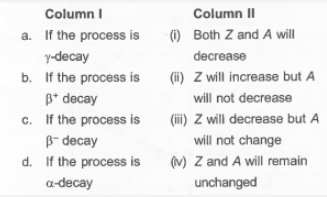In a series of radioactive decays, if a nucleus of mass number 180 and atomic number 72 decays into another nucleus of mass number 172 and atomic number 69, then the number of αandβ particles released respectively are
A
2, 3
B
2, 2
C
2, 1
D
2, 0
Text Solution
The correct Answer is:B
Mass number of nucleus is decreased by 8 and atomic number is decreased by 3. So, the number of α-particles are two and number of β-particles is one.
18072X→17269Y(α−decay)+2(42He)(β−decay)+0−1e
|
Similar Questions
Knowledge Check
When a nucleus undergoes radioactive decay, its new mass number is
Aalways equal to its original mass numberBalways more than its original mass numberCnever more than its original mass numberDnever less than its original mass numberA nucleus with mass number m and atomic number n, emits one α− particle and one β− particle . The mass number and atomic number of the resulting nucleus will respectively be-
A(m−2),nB(m−4),(n−1)C(m−4),(n−2)D(m+4),(n−1)A nucleus of atomic mass A and atomic number Z emits β−particle. The atomic mass and atomic number of the resulting nucleus are
AA,ZBA+1,ZCA,Z+1DA−4,Z−2
Mass number of a nucleus X is A and atomic number is Z. Find mass number and atomic number of the new nucleus (say Y) after the emission of m-alpha particles and n-beta particles.
View SolutionMass number of a nucleus X is A and atomic number is Z. Find mass number and atomic number of the new nucleus (say Y) after the emission of m-alpha particles and n-beta particles.
View SolutionA nucleus undergoes β-decay. How does its (i) mass number, (ii) atomic number change ?
View SolutionWhich type of radioactive decay produces a daughter nucleus with a higher atomic number?
View SolutionIf the atomic number and the mass number of X are 72 and 180 then the mass number and atomic number of X4 are-
View Solution

